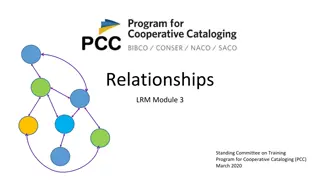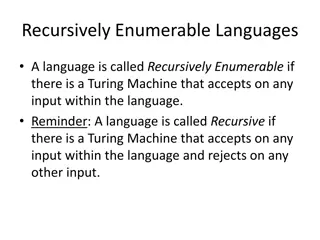Understanding One-to-One and Recursive Relationships in Data Modeling
Explore the concepts of one-to-one and recursive relationships in data modeling through images and explanations. Learn about labeling relationships, mapping foreign keys, and creating tables in MySQL Workbench. Dive into examples showcasing 1:1 relationships and recursive relationships, with insights on entity relationships and data structure presentations.
Download Presentation

Please find below an Image/Link to download the presentation.
The content on the website is provided AS IS for your information and personal use only. It may not be sold, licensed, or shared on other websites without obtaining consent from the author. Download presentation by click this link. If you encounter any issues during the download, it is possible that the publisher has removed the file from their server.
E N D
Presentation Transcript
One-to-One and Recursive Relationships Self-reflection is the school of wisdom Baltastar Graci n
An organization chart Every structure for presenting data has an underlying data model 2
Modeling a 1:1 relationship 1:1 relationship is labeled A relationship descriptor Obvious relationships are not labeled 3
Labeling a relationship Workbench Preferences > Diagram Turn off hide captions 4
Labeling a relationship Enter caption or blank an unwanted captions 5
Modeling a recursive relationship A recursive relationship relates an entity to itself Label recursive relationships 6
Mapping a 1:1 relationship Usual rules apply Where do you put the foreign key? DEPT EMP What is mandatory? A department must have a boss? An employee must be a boss? Opt for the entity with the mandate 8
Mapping a recursive relationship Usual rules 1:m The entity gets an additional column for the foreign key Need a name different from the primary key 9
Results of the mapping dept *deptname Management Marketing Accounting Purchasing Personnel & PR empno deptfloor deptphone 5 1 4 4 1 2001 2002 2003 2004 2005 1 2 5 7 9 emp *empno empfname Alice Ned Andrew Clare Todd Nancy Brier Sarah Sophie empsalary 75000 45000 25000 22000 38000 22000 43000 56000 35000 deptname Management Marketing Marketing Marketing Accounting Accounting Purchasing Purchasing Personnel & PR bossno 1 2 3 4 5 6 7 8 9 1 2 2 1 5 1 7 1 10
Creating the tables CREATE TABLE dept ( deptname VARCHAR(15), deptfloor SMALLINT deptphone SMALLINT empno SMALLINT PRIMARY KEY(deptname)); There is no foreign key constraint for empno in dept, because it requires the matching primary key in emp to exist. However, the matching foreign key in emp can t be created until the matching primary key in dept exists. An infinite circle of references. NOT NULL, NOT NULL, NOT NULL, CREATE TABLE emp ( empno SMALLINT, empfname VARCHAR(10), empsalary DECIMAL(7,0), deptname VARCHAR(15), bossno SMALLINT, PRIMARY KEY(empno), CONSTRAINT fk_belong_dept FOREIGN KEY(deptname) REFERENCES dept(deptname), CONSTRAINT fk_has_boss foreign key (bossno) REFERENCES emp(empno)); 11
Inserting rows INSERT INTO emp (empno, empfname, empsalary, deptname,bossno) VALUES (1,'Alice',75000,'Management'); INSERT INTO emp VALUES (2,'Ned',45000,'Marketing',1); INSERT INTO emp VALUES (3,'Andrew',25000,'Marketing',2); INSERT INTO emp VALUES (4,'Clare',22000,'Marketing',2); INSERT INTO emp VALUES (5,'Todd',38000,'Accounting',1); INSERT INTO emp VALUES (6,'Nancy',22000,'Accounting',5); INSERT INTO emp VALUES (7,'Brier',43000,'Purchasing',1); INSERT INTO emp VALUES (8,'Sarah',56000,'Purchasing',7); INSERT INTO emp VALUES (9,'Sophie',35000,'Personnel',1); Order the INSERTs to avoid referential integrity problems 12
Exercise Several Olympic events are team sports (e.g., basketball, relays) and some involve a pair of athletes (e.g., kayaking, rowing, beach volleyball) A team can have a captain A country has a flag bearer There can be some husband-and-wife pairs at a games (e.g., Jared Tallent and Claire Woods from Australia) Draw a data model to record these details 13
Querying a 1:1 relationship List the salary of each department s boss. SELECT empfname, deptname, empsalary FROM emp WHERE empno IN (SELECT empno FROM dept); empfname deptname empsalary Alice Management 75000 Ned Marketing 45000 Todd Accounting 38000 Brier Purchasing 43000 Sophie Personnel & PR 35000 14
Querying a 1:1 relationship List the salary of each department s boss. SELECT empfname, dept.deptname, empsalary FROM emp JOIN dept ON dept.empno = emp.empno; empfname deptname empsalary Alice Management 75000 Ned Marketing 45000 Todd Accounting 38000 Brier Purchasing 43000 Sophie Personnel & PR 35000 15
Joining a table with itself Find the salary of Nancy s boss. wrk *empno empfname Alice Ned Andrew Clare Todd Nancy Brier Sarah Sophie empsalary 75000 45000 25000 22000 38000 22000 43000 56000 35000 deptname Management Marketing Marketing Marketing Accounting Accounting Purchasing Purchasing Personnel & PR bossno 1 2 3 4 5 6 7 8 9 1 2 2 1 5 1 7 1 boss *empno empfname Alice Ned Andrew Clare Todd Nancy Brier Sarah Sophie empsalary 75000 45000 25000 22000 38000 22000 43000 56000 35000 deptname Management Marketing Marketing Marketing Accounting Accounting Purchasing Purchasing Personnel & PR bossno 1 2 3 4 5 6 7 8 9 1 2 2 1 5 1 7 1
Querying a recursive relationship Find the salary of Nancy s boss. Make two copies of emp WITH wrk AS (SELECT * FROM emp), boss AS (SELECT * FROM emp) SELECT wrk.empfname, wrk.empsalary, boss.empfname, boss.empsalary FROM wrk JOIN boss ON wrk.bossno = boss.empno WHERE wrk.empfname = 'Nancy' wrk boss *empno empfname empsalary deptname bossno *empno empfname empsalary deptname bossno 2 Ned 45000 Marketing 1 1 Alice 75000 Management 3 Andrew 25000 Marketing 2 2 Ned 45000 Marketing 1 4 Clare 22000 Marketing 2 2 Ned 45000 Marketing 1 5 Todd 38000 Accounting 1 1 Alice 75000 Management 6 Nancy 22000 Accounting 5 5 Todd 38000 Accounting 1 7 Brier 43000 Purchasing 1 1 Alice 75000 Management 8 Sarah 56000 Purchasing 7 7 Brier 43000 Purchasing 1 9 Sophie 35000 Personnel & PR 1 1 Alice 75000 Management wrk.empfname wrk.empsalary boss.empfname boss.empsalary Nancy 22000 Todd 38000 17
Querying a recursive relationship Find the names of employees who earn more than their boss. WITH wrk AS (SELECT * FROM emp), boss AS (SELECT * FROM emp) SELECT wrk.empfname FROM wrk JOIN boss ON wrk.bossno = boss.empno WHERE wrk.empsalary > boss.empsalary; wrk boss *empno empfname empsalary deptname bossno *empno empfname empsalary deptname bossno 2 Ned 45,000 Marketing 1 1 Alice 75,000 Management 3 Andrew 25,000 Marketing 2 2 Ned 45,000 Marketing 1 4 Clare 22,000 Marketing 2 2 Ned 45,000 Marketing 1 5 Todd 38,000 Accounting 1 1 Alice 75,000 Management 6 Nancy 22,000 Accounting 5 5 Todd 38,000 Accounting 1 7 Brier 43,000 Purchasing 1 1 Alice 75,000 Management 8 Sarah 56,000 Purchasing 7 7 Brier 43,000 Purchasing 1 9 Sophie 35,000 Personnel & PR 1 1 Alice 75,000 Management empfname 18 Sarah
Exercise Find the names of employees in the same department as their boss 19
Modeling a 1:1 recursive relationship The English monarchy 20
Mapping a 1:1 recursive relationship montype *monname *monnum rgnbeg premonname premonnum Queen Victoria I 1837/6/20 William IV King Edward VII 1901/1/22 Victoria I King George V 1910/5/6 Edward VII King Edward VIII 1936/1/20 George V King George VI 1936/12/11 Edward VIII Queen Elizabeth II 1952/2/6 George VI Charles King III 2022/9/8 Elizabeth II 22
Enforcing a 1:1 recursive relationship A 1:1 recursive relationship means that the foreign key must be unique for its column There can be only one matching primary key Add a UNIQUE INDEX constraint to the foreign key column A uniqueness constraint does not prevent the column from being NULL 23
Creating the table CREATE TABLE monarch ( montype monname monnum rgnbeg premonname premonnum PRIMARY KEY(monname,monnum), UNIQUE INDEX uniq_monarch (premonname,premonnum), CONSTRAINT fk_monarch FOREIGN KEY (premonname, premonnum) REFERENCES monarch(monname, monnum)); relationship VARCHAR(5), VARCHAR(15) VARCHAR(5) DATE, VARCHAR(15), VARCHAR(5), NOT NULL, NOT NULL, Enforces 1:1 recursive 24
Mapping 1:1 recursive & 1:m recursive Both add a foreign key to the same table 1:1 recursive Specify that the foreign key must be unique 1:m recursive No uniqueness specification 25
Mapping 1:1 recursive & 1:m recursive Spouse must be a unique column Multiple people can have same father 26
Inserting rows INSERT INTO monarch (montype,monname, monnum,rgnbeg) VALUES ('King','William','IV','1830-06-26'); INSERT INTO monarch VALUES ('Queen','Victoria','I','1837-06-20','William','IV'); INSERT INTO monarch VALUES ('King','Edward','VII','1901-01-22','Victoria','I'); INSERT INTO monarch VALUES ('King','George','V','1910-05-06','Edward','VII'); INSERT INTO monarch VALUES ('King','Edward','VIII','1936-01-20','George','V'); INSERT INTO monarch VALUES ('King','George','VI','1936-12-11','Edward','VIII'); INSERT INTO monarch VALUES ('Queen','Elizabeth','II','1952-02-06','George','VI'); INSERT INTO monarch VALUES ('King','Charles','III','2022-09-08','Elizabeth','II'); 27
Exercise Design a database to record details of all Olympic cities Recognize that a city can host an Olympics more than once, though a particular Olympics is in only one city at a time Recognize that each Olympics has only one predecessor and successor 28
Querying a 1:1 recursive relationship Who preceded Elizabeth II? SELECT premonname, premonnum FROM monarch WHERE monname = 'Elizabeth' and monnum = 'II'; premonname premonnum George VI 29
Querying a 1:1 recursive relationship Was Elizabeth II's predecessor a king or queen? WITH cur AS (SELECT * FROM monarch) pre AS (SELECT * FROM monarch), SELECT pre.montype FROM cur JOIN pre ON cur.premonname = pre.monname AND cur.premonnum = pre.monnum WHERE cur.monname = 'Elizabeth' AND cur.monnum = 'II'; cur montype *monname *monnum rgnbeg premonname premonnum montype Queen Elizabeth II 1952/2/6 George VI King pre montype *monname *monnum rgnbeg premonname premonnum King 30 1936/12/11 George Vi Edward VIII
Querying a 1:1 recursive relationship List the kings and queens of England in ascending chronological order. SELECT montype, monname, monnum, rgnbeg FROM monarch ORDER BY rgnbeg; montype monname monnum rgnbeg Queen Victoria I 1837-06-20 King Edward VII 1901-01-22 King George V 1910-05-06 King Edward VIII 1936-01-20 King George VI 1936-12-11 Queen Elizabeth II 1952-02-06 King Charles III 2022-09-08 31
Exercise Add details of the last three summer Olympics cities Use SQL to determine which city was the host before London in 2008. 32
Modeling an m:m recursive relationship Bill of materials problem A product can appear as part of many other products and can be made up of many products 33
Mapping an m:m recursive relationship product assembly *prodid proddesc prodcost prodprice quantity *prodid *subprodid 1000 Animal photography kit 725 1 1000 101 101 Camera 150 300 1 1000 102 102 Camera case 10 15 1 1000 103 103 70-210 zoom lens 125 200 1 1000 104 104 28-85 zoom lens 115 185 1 1000 105 105 Photographer s vest 25 40 2 1000 106 106 Lens cleaning cloth 1 1.25 1 1000 107 107 Tripod 35 45 4 1000 108 108 16 GB SDHC memory card 30 30 35
Creating the tables CREATE TABLE product ( prodid INTEGER, proddesc VARCHAR(30), prodcost DECIMAL(9,2), prodprice DECIMAL(9,2), PRIMARY KEY(prodid)); CREATE TABLE assembly ( quantity INTEGER prodid INTEGER, subprodid INTEGER, PRIMARY KEY(prodid, subprodid), CONSTRAINT fk_assembly_product FOREIGN KEY(prodid) REFERENCES product(prodid), CONSTRAINT fk_assembly_subproduct FOREIGN KEY(subprodid) REFERENCES product (prodid)); NOT NULL, 36
Exercise In a round-robin tournament, each contestant meets all other contestants in turn In the Olympics, it is common for an event with a large pool of contestants to be broken into groups, with a round-robin tournament in each group to determine who advances from the group to the next level Design a data model to record details of a round-robin competition 37
Querying an m:m recursive relationship List the product identifier of each component of the animal photography kit. SELECT subprodid FROM product JOIN assembly ON product.prodid = assembly.prodid; WHERE proddesc = 'Animal photography kit' subprodid 101 106 107 105 104 103 102 108 38
Querying an m:m recursive relationship List the product description and cost of each component of the animal photography kit. SELECT proddesc, prodcost FROM product WHERE prodid IN (SELECT subprodid FROM product JOIN assembly ON proddesc = 'Animal photography kit' WHERE product.prodid = assembly.prodid); proddesc prodcost Camera 150.00 Camera case 10.00 70-210 zoom lens 125.00 28-85 zoom lens 115.00 Photographer s vest 25.00 Lens cleaning cloth 1.00 Tripod 35.00 16 GB SDHC memory card 30.00 39
Exercises Model the following situations Friendship Course prerequisites A matrix organization where a person can report to multiple people 40
Exercise Insert data in the round-robin database for the 2012 Football (Soccer) competition for Group A, with four teams See http://www.london2012.com/football/schedule-and-results/ How many ties were there in Group A? Use the ISO two-character country code to identify countries http://en.wikipedia.org/wiki/ISO_3166-1_alpha-2 41
Exercise Model a diagram 42
Conclusion Introduced Recursive relationship Self-referential constraint Self-join 43























